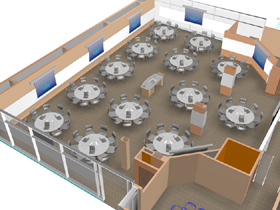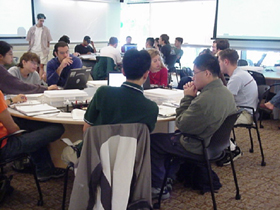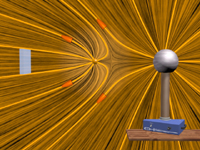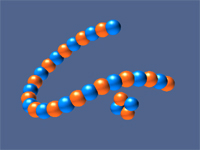| Guided Tour | Vector Fields | Electrostatics | Magnetostatics | Faraday's Law | Light | Course Notes | Resources |


Technology Enabled Active Learning |
||||||||||||||||||
|---|---|---|---|---|---|---|---|---|---|---|---|---|---|---|---|---|---|---|
Visualizing Electricity and Magnetism at MITWe are using visualizations in teaching physics interactively in freshman courses at MIT (classes of 500 students). We combine desktop experiments with visualizations of those experiments to "make the unseen seen". Our pedagogy utilizes the following elements:
Our visualizations are organized into five categories: Vector Fields, Electrostatics, Magnetostatics, Faraday's Law, and Light. Here we present a selected few from over 100 visualizations ranging in format from passive mpeg animations to interactive Shockwave and Java 3D applets. The main index is available at http://web.mit.edu/8.02t/www/802TEAL3D. The content contained herein can be freely used and redistributed for non-profit educational purposes, as long as an acknowledgment is given to the MIT TEAL/Studio Physics Project for such use. Electrostatics:
Magnetostatics:
|
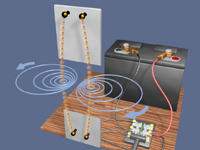 |
Title: Two
Wires in Series An animation of the magnetic field and forces generated by two parallel wires is visualized when the current in the wires run in opposite directions. When the current is turned on, the resulting magnet field pressure between the wires pushes them apart. |
Faraday's Law:
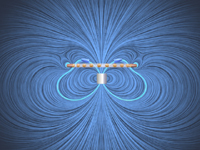 |
Title: The
Falling Ring with Finite Resistance A visualization of the magnetic field configuration that is generated around a conducting non-magnetic ring (e.g. copper) as it falls under gravity in the magnetic field of a fixed permanent magnet. The current in the ring is indicated by the small moving spheres. In this case, the ring has finite resistance and falls past the magnet. Set Windows Media Player to "repeat". |
|
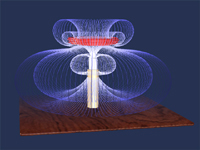 |
Title: The
Falling Coil Applet An interactive Java 3D applet field shows the field configuration around a non-magnetic ring as it falls under gravity in the field of a fixed magnet. In the initial configuration the coil has no resistance and levitates in the field of the magnet. Hit run and let the ring bounce several times. At the bottom of a bounce hit the "iron filings" box to see a representation of the complete field. Hit run again and increase the resistance to "10" using the slider. Watch the subsequent behavior of the ring. |
CLICK HERE FOR MORE EXAMPLES
Funding:
The Alex and Brit d'Arbeloff Fund for Excellence in MIT Education, MIT iCampus, the Davis Educational Foundation, NSF, the Class of 1960 Endowment for Innovation in Education, the Class of 1951 Fund for Excellence in Education, the Class of 1955 Fund for Excelence in Teaching, and the Helena Foundation.
Credits:
Pedagogy: John Belcher, Peter Dourmashkin, Sen-ben Liao, David Litster, Norman Derby, Stanislaw OlbertAssessment: Yehudit Judy Dori
TEAL Visualizations:
Project Manager: Andrew McKinney
Java Simulations: Andrew McKinney, Philip Bailey, Michael Danziger, Mesrob Ohannesian, Pierre Poignant, Ying Cao
3D Illustration/Animation: Mark Bessette, Michael Danziger
Shockwave Visualizations: Michael Danziger
Visualization Techniques R&D: Andreas Sundquist (DLIC), Mesrob Ohannessian (IDRAW)
| – Guided Tour – Vector Fields – Electrostatics – Magnetostatics – Faraday's Law – Light – Course Notes – Resources – |
